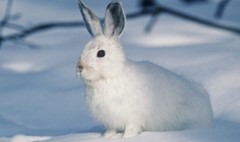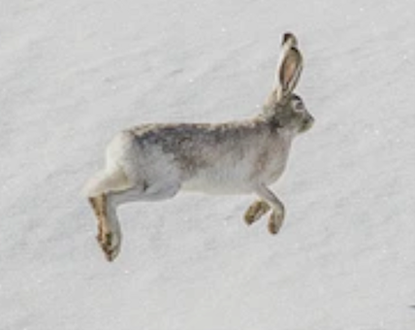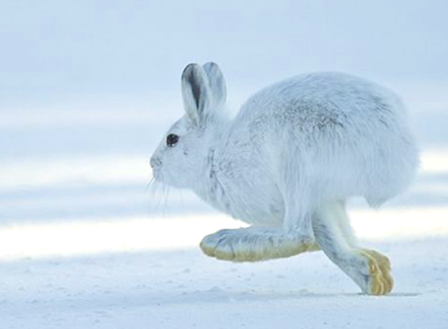by Leonard Lepus

From left: The White-tailed jackrabbit (a hare – some are black-tailed), cottontail rabbit, and snowshoe hare are the native to Alberta. In the city, you may also, occasionally, see domestic rabbits that have escaped or been set free, but (with our hawks, bobcats, and coyotes) they tend not to last very long.
The cottontails (which you might see in Weaselhead) stay close to thickets in the prairie bottoms and their fur colour may not change fully to white in winter.
Hares tend to have longer ears and feet. Unlike rabbits, they are born with fur and their eyes open, and they live a solitary life, except when mating (February through July). Rabbits are born hairless, with eyes closed, and tend to be more sociable with each other.
Both rabbits and hares belong to the Lagomorph family, a family that also includes the mountain-dwelling pika. The white-tailed jackrabbits (Lepus townsendii) are masters of evasion. If detected, they bound away, often in a zigzag pattern, reaching up to 55 kilometers per hour. They are capable of leaping up to five meters. Although silent, they can scream when injured or caught. They are good swimmers and can use their powerful hind legs to kick at predators when captured.
Jackrabbits like open spaces and can be found in urban parks, yards, and schoolyards. Except when breeding, they normally rest by day and come out to feed when it is dark. Rabbits and hares can have multiple litters each year. With a gestation period of about 42 days, females prepare fur-lined nests and give birth to a litter of four to five leverets (also called “kits” or “bunnies”), which have no scent for predators to detect. They start foraging at around two weeks and are weaned by four weeks.
In the wild, rabbits have a relatively short lifespan, averaging about one to two years due to predation and environmental factors.
Wildlife rehabilitation centres, humane societies, and veterinary clinics will usually get calls about “baby bunnies” starting in April. Many people think they have been abandoned because they have been found alone. Because they do have a scent, females leave their young for extended periods to avoid attracting predators. They are known to make huge jumps when approaching their nests, to leave less of a scent trail.
Baby hares do not survive well in captivity. Good-hearted people are often heartbroken when the baby they “saved” dies due to the stress of handling, change of milk formula, and unnatural captive environment. Wildlife can also carry diseases and parasites that may not be obviously visible.
The mantra for interacting with baby hares is “if you see a baby hare, leave it there.” Contrary to myths, the mother won’t abandon their young if touched by humans, therefore, returning them to the area they were found is the best course of action.
Sources:
• https://www.aiwc.ca/blog/white-tailed-jackrabbits-natures-master-survivors/.
Click here to the Bayview Community News home page for the latest Bayview community updates.
Click here to the Palliser Community News home page for the latest Palliser community updates.
Click here to the Pumphill Community News home page for the latest Pumphill community updates.













